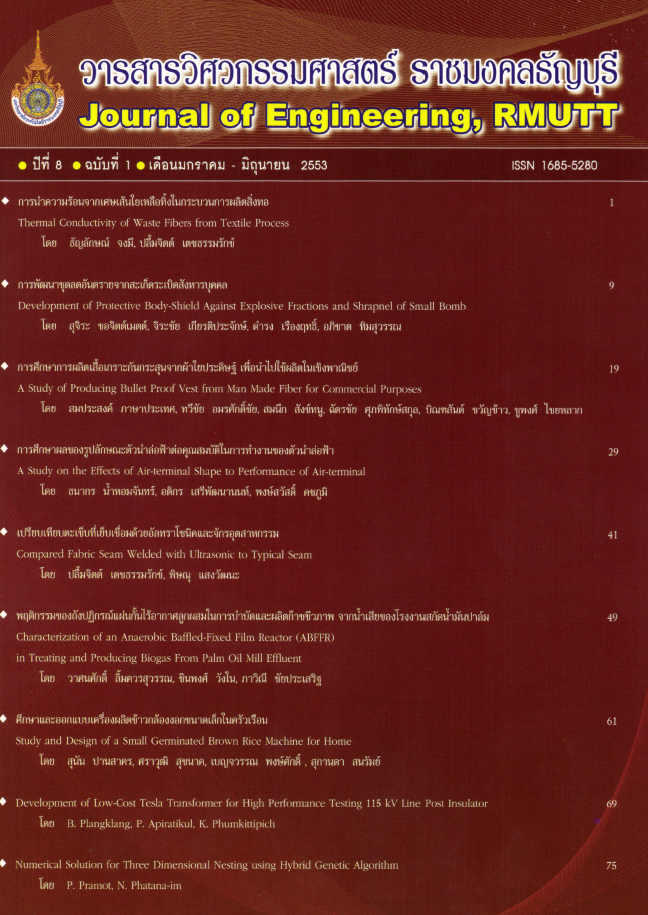Chracterization of an Anaerobic Baffled- Fixed Film Reactor (ABFFR) in Treating and Producing Biogas From Palm oil mill Effluent
Main Article Content
Abstract
The anaerobic baffled-fixed film reactor (ABFFR) in this study was designed for enhancing the biodegradation ofhigh organic matter and suspended solid (SS) in palm oil mill effluent (POME). An ABFFR was developed by a baffledprocess combined with plastic nets fitted inside the last fourth compartment of reactor. POME containing high concentrationof CoD (65,120 + 1,000 mg L'') and SS (21,060+ 550 mg L-') was semi-continuously upflow fed at 1.2 L d'r. During theoperation, the overall performance of ABFFR in term of COD and SS removal were 90yo and 80%, respectively withmethane production of 6.9 L d-'.The perfonnance characteristics of the first to third baffle compartment act as hydrolysis andfermentation chamber by hydrolyzing cellulose at68,22 and,g.SYo,respectively. pH was in acidic range of 4.5 - 5.0. Volatilefatty acid was found approximately 8-9 g L-' which acetate was major found and followed by butyrate and propionate inthree compartments. The fourth compartment acts as methanogenic chamber with pH of 7.7 and less volatile fatty acidsaccumulation. High biogas and methane production was found. Biogas and methane yield were 0.37 - 0.52 and,0.26 - 0.37m3 kg-t soluble COD removed, respectively
Article Details
The manuscript, information, content, picture and so forth which were published on Frontiers in engineering innovation research has been a copyright of this journal only. There is not allow anyone or any organize to duplicate all content or some document for unethical publication.
References
Chaiprasert, P., Nopharatana, A., Pepatung, N.,Kullavanijaya, P., Songkasiri, W., and Loapitinun, A. 2006.Final report: An Overview of Status and Potential of Biogas Production from BioWaste in Thailand,submitted to Joint Graduate School of Energy and Environment, King Mongkut's University of Technology Thonburi (in Thai).
Ministry of Energy and Ministry of Agriculture and Cooperative .2005. Development strategy and Promotion of Biodiesel Utilization from Palm oil, [2005, January 18].
Jetsada Chotwattanasak. 2004. "Treatment of Palm Oil Mill Effluent by High Rate Anaerobic Digester". Thesis of Master Degree of Science in Environmental Technology, King
Mongkut's University of Technology Thonburi, Bangkok.
Bureau of Water Technology and Industrial Pollution Management.1997.Environmental
Management of Palm Oil Mill Industry.Bangkok.
Ichroj, S. 2004. "CSTR Biogas Technology." The Expertise Meeting in Biomass Technologw
Biogas System and Waste Managementin Animal Farms, 27 February.
Puetpaiboon U. and Chotwattanasak J. 200S. "An Anaerobic Treatment of Palm Oil Mill
Wastewater under Mesophilic Condition"[Online] Available:http://web.eng.psu.ac.th/enghome/web_Guideline/Treatment%,20Web/Puetpaiboon_U.pdf (retrieved June19th, 2005)
โสภณ บุญมั่น, สมชายคารารัตน์, ชาญวิทย์ โฆบิต นนท์ และสุรภี เบญจปัญญาวงศ์. 2549."ผลของการเติมโพลีเมอร์ต่อการเกิดเม็ดตะกอนจุลินทรีย์และการผลิตก๊าซชีวภาพากน้ำเสียโรงงานสกัดน้ำมันปาล์มโดยใช้ระบบยูเอเอสบี," การประชุมวิชาการสิ่งแวดล้อมแห่งชาติ. ครั้งที่ 5, วันที่ 8-10 มีนาคม 2549
จุฑามาศโคตรพันธ์และสาโรชบุญขกิจสมบัติ.2550"สมรรถนะของระบบยูเอเอสบีที่บำบัดน้ำถึงโรงสกัดน้ำมันปาล์ม." การประชุมวิชาการส่งแวดล้อมแห่งชาติ. ครั้งที่ 6, วันที่ 7-9 มีนาคม 2550.
ชกาญจน์ ชาติดวงเพชร, กาญนิถา ครองธรรมชาติ.สมชาย คารารัตน์ ณัฐวุฒิ บุญเลี่ยม และ.ชัชชาย แจ่มใส. 2550. "ประสิทธิภาพของระบบแอนแอโรบิกซีเควนซิ่งแบทรีแอกเตอร์(ออสบีอาร์) ในการบำบัดสารอินทรีย์ในน้ำเสียโรงงานผลิตน้ำมันปาล์ม."การประชุมวิชาการสิ่งแวดล้อมแห่งชาติ. ครั้งที่ 6, วันที่ 7-9 มีนาคม 2550.
Shahrakbah, Yacob., Yoshihito, Shirai., Mohd, Ali Hassan., Minato, Wakisaka., Sunderaj,
Subash. 2006. "Start-up operation of semicommercial closed anaerobic digester for palm oil mill effluent treatment ." Process Biochemistry. Vol.41, pp.962-964.
G.D. Najafpour., A.A.L. Zinatizadeh., A.R.Mohamed., M.Hasnain Isa., H.Nasrollahzadeh. 2006. "High-rate anaerobic digestion of palm oil mill effluent in an upflow anaerobic sludge fixed film bioreactor." Process Biochemistry. Vol.41,pp.370-379.
APHA (American Public Health Association).AWWA (AmericanWaterWorksAssociation), and WEF (Water Environment Federation). 1999. Standard methods for the examination of water and wastewater (20th edition). Washington DC: USA.
Van Soest, P. J. 1963. "Use of detergents in the analysis of fibrous feeds II. A rapid method for the determination of fiber and lignin."J. Assoc. offic. Anat.Chem. M829.
Ren, N.Q., Zhao, D., Chen, X.L., Li, J.Z., 2002."Mechanism and controlling strategy of the
production and accumulation of propionic Science in China (Series B. Vol.45, No.3,pp.319-327.
Mensah, K.A., Forster, C.F., 2003."An examination of the effects of detergents on anaerobic digestion." Bioresource Technology.Vol.90, pp.133-138.
มั่นสิน ตัณฑุลเวศน์. 2325, การออกแบบขั้นกระบวนการของระบบบำบัดน้ำเสียโดยวิธีชีววิทยา.กรุงเทพๆ : โรงพิมพ์แห่งจุฬาลงกรณ์มหาวิทยาลัย.
สมาคมวิศวกรสิ่งแวดล้อมไทย. 2540. ค่ากำหนดการออกแบบระบบบำบัดน้ำเสีย. กรุงเทพา : เรือนแก้วการพิมพ์.
สัดทัด ศิริอนันต์ไพบูลย์. 2549. ระบบบำบัดน้ำเสีย.กรุงเทพฯ : ทอป.
ธนาวัฒน์ รักกมล, สุเมธ ไชยประพัทธ์, อุดมผล
พืชน์ไพบูลย์. 2549. "ประสิทธิภาพของระบบบำบัดน้ำเสียเอเอสบีอาร์ แบบเทอร์โมฟีลิกและมีโซฟีลิก ในการบำบัดน้ำเสียโรงงานสกัดน้ำมันปาล์ม" การประชุมวิชาการสิ่งแวดล้อมแห่งชาติ. ครั้งที่ 5, วันที่ 8-10 มีนาคม 2549.
Richard E. Speece. 1996. Anaerobic biotechnology for industrial wastewaters. Nashville : Archae Press.
รนัสนี สมบูรณ์, กาญจนา นาถะพินรุ, กาญนิถา ครองธรรมชาติ, สมชายคารารัตน์. 2550."ประสิทธิภาพของระบบแอนแอโรบิกไมเกรทติ้งแบลงค์เก็ตรีแอกเตอร์ในการบำบัดสารอินทรีย์ในน้ำเสียโรงงานผลิตน้ำมัน
ปาล์ม." การประชุมวิชาการสิ่งแวดล้อมแห่งชาติ. ครั้งที่6,วันที่ 9มีนาคม 2550.


